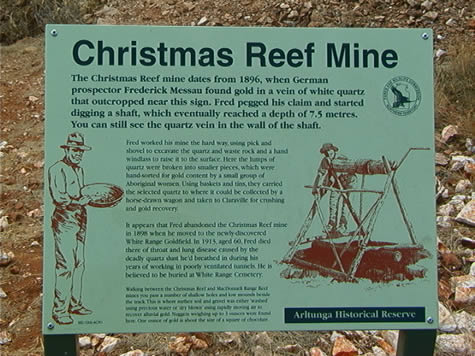“Scattered around you are some evocative reminders of the extreme hardships that the early gold miners had to endure. Imagine spending your day hunched over in a low, dark tunnel as you hack away at a rock face with your pick. Finally it’s time to down tools and head home dirty and exhausted to your makeshift camp in the scrub. Water is scarce and expensive, so a cleansing shower is out of the question, likewise a ‘refreshing glass of beer’ to wash the dust out of your throat…”
The vein of white quartz, in sharp contrast to the red rock it snaked through, stood out in the low light of the mineshaft. On hands and knees, four metres below ground level, Crister and I inched our way through the tunnel’s narrow opening. Old Fred and his counterparts had tunnelled out an amazing underground network , following the white quartz path which contained the gold.

The Christmas Reef Gold Mine, the first in the Arltunga area, was established in 1896 by German Frederick Messaur. Fred had discovered the gold ore in an outcropping of white quartz. Digging 7.5 meters below ground, he used a pick and shovel to excavate the quartz. A rope, pulley, and bucket hauled the rock to the surface where Aboriginal women sorted the stones. Using baskets and tins, the ore was carried to a horse-drawn wagon for extraction of the gold ore at nearby Claraville where the crushing and extraction of the gold was completed. In 1898, Fred left the Christmas Reef bound for the White Range gold fields. He died in 1913 from complications of breathing deadly quartz dust in poorly ventilated mine shafts.
In 1898, Henry Luce and partner Micheal Vikson established the MacDonnell Range Reef. Working the mine intermittently from 1892 to 1908, it produced 248 ounces of gold from 353 tonnes of ore, which made it one of the area’s largest and richest mines outside of the White Range mines. Three- ounce nuggets of gold ore were discovered in the area (the size of one ounce is equal to one square of chocolate) Henry then went on to discover the White Range goldfield in 1898.
Quartz lay scattered across the ground as far as the eye could see as Crister and I climbed up from the mineshaft. It was easy to imagine how gold fever affected the miners who would gladly put up with the harsh conditions of Outback mining in the hopes of striking it rich.
Suggested activities: Investigate mining in your area. How does it impact the economy? What metals are being mined and what are they used for? Examine the types of rock that veins of gold have been extracted from in your region.
April